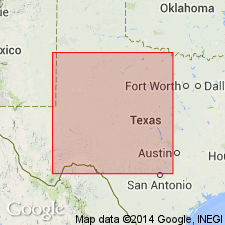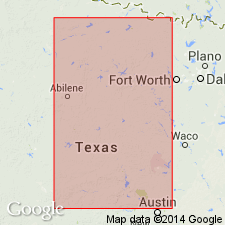
- Usage in publication:
-
- Caddo Pool formation
- Modifications:
-
- Original reference
- Dominant lithology:
-
- Limestone
- Sandstone
- AAPG geologic province:
-
- Bend arch
Summary:
Pg. 66 (fig. 1), 84 (fig. 5), 86. Caddo Pool formation. Proposed for middle formation of Smithwick group (revised). Consists principally of about 200 feet of dense black spicular limestone with some thin sandstones in lower part. Overlies Eastland Lake formation (new); underlies Parks formation (new). Age is Pennsylvanian (Lampasas).
Type section (subsurface): depth-interval 3,820 to 3,960 ft, Anzac Oil Corp. et al E.S. Graham No. 1 well, in Allen Hines Survey, Abstract 135, central Young Co., north-central TX. Discovery well of Caddo Pool of eastern Stephens Co. was completed in this black limestone which is colloquially known as the "Caddo lime"; hence the name.
Source: US geologic names lexicon (USGS Bull. 1200, p. 572).

- Usage in publication:
-
- Caddo Pool formation
- Modifications:
-
- Revised
- AAPG geologic province:
-
- Bend arch
Summary:
Pg. 209. Stratigraphic section assigned to Kickapoo Creek group (new) includes the Rayville (new), Parks and Caddo Pool formations. Age is Pennsylvanian (Lampasas). [Some reports place Kickapoo Creek group in Strawn Series.]
Source: US geologic names lexicon (USGS Bull. 1200, p. 572).
For more information, please contact Nancy Stamm, Geologic Names Committee Secretary.
Asterisk (*) indicates published by U.S. Geological Survey authors.
"No current usage" (†) implies that a name has been abandoned or has fallen into disuse. Former usage and, if known, replacement name given in parentheses ( ).
Slash (/) indicates name conflicts with nomenclatural guidelines (CSN, 1933; ACSN, 1961, 1970; NACSN, 1983, 2005, 2021). May be explained within brackets ([ ]).

